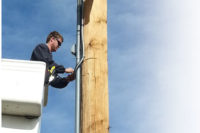Lower-cost technology, along with new IP broadband and cellular data connectivity, has made video surveillance a more viable option for homeowners and small-business owners than in the past. Many of today’s intrusion protection panels are now designed with video in mind.
SDMtalked to key manufacturers about their offerings in this area and what dealers need to know about how their control panel choice impacts their video camera choice and vice versa.
The Control Panel’s Role in Video Surveillance
People love their smartphones — and they like having the ability to check in on video cameras installed inside or outside of their homes. That’s a capability customers can get from today’s IP cameras, even if they don’t have an alarm system or their alarm systems aren’t linked to their cameras.
Smartphones become even more powerful when a customer’s video and alarm system are interconnected, however. When a system is configured in that manner, homeowners and business owners can have video images automatically sent to their smartphones in the event of an alarm: for example, if someone disarms the system. Some customers also may want video to be sent to the central station when an intrusion alarm is generated so that central station operators can gauge whether the alarm was generated by a real intruder — a service commonly known as video verification that can earn dealers additional recurring monthly revenue (RMR).
“What’s key is that the central station gets the video and does something with it,” comments Keith Jentoft, president of Minneapolis-based equipment manufacturer Videofied. “What’s of value is taking that video and being able to summon the police, who will treat it like a crime in progress.”
Some manufacturers design their intrusion systems and cameras to work with one another, but not with equipment from other manufacturers. But at least two manufacturers — Videofied and Resolution Products (Hudson, Wis.) — offer modules or hubs designed to enable their video offerings to be used with panels from various manufacturers, allowing video and alarm signals to report to the central office as a single account.
Communications Options
Some of the decisions dealers must make about intrusion systems that have video capability involve communications — both between the camera and the panel and from the panel to the outside world.
Several manufacturers use WiFi to communicate between the video and the panel. Other communications options include proprietary wireless communications and hardwired Ethernet connections.
At least one manufacturer — San Jose, Calif.-based Qolsys Inc. — offers a self-contained panel and keypad with a built-in camera, eliminating the need to interconnect the panel and the video camera. The current model stores snapshots of anyone who disarms the system. In the works for mid-2015 is the ability to also send images to customers’ smartphones, explains Mike Hackett, senior vice president of sales and marketing for Qolsys.
As for connectivity from the customer premises to the outside world, the two most common choices for intrusion systems that include video are to use a cellular data connection or a landline broadband connection. Examples of the latter are DSL, cable modems, and fiber Internet.
Tom Karl, vice president of business development for Amityville, N.Y.-based manufacturer Napco Security Systems, argues that a landline connection is preferable because it provides more bandwidth, enabling video images to be transferred more quickly. He says Napco is able to send short video clips to customers because the company relies on landline broadband, while products designed to use cellular data instead of or in addition to broadband are more likely to be designed to send a still image. It’s easier to determine what is going on from a clip than from a still, Karl adds.
Another advantage of using landline broadband is that, unlike cellular data, it doesn’t entail a monthly charge (beyond what customers are already paying for Internet connectivity). But not all customers have landline broadband and some dealers are wary of using it because they don’t want to touch the customer’s broadband equipment.
The Cloud
Another decision alarm dealers must make is whether or not to use a cloud-based approach for sending video and other system information to end users and to the central station.
Some panels are designed to work with a cloud-based service from the manufacturer or a third party such as Alarm.com. With this approach, video is sent over a landline broadband or cellular data connection to servers located in a data center operated by the cloud provider.
From there video images or a link to a server storing video images is sent to the end user’s smartphone and, if appropriate, to the central station. Customers may need to download an app to their smartphone to use some of these services, although at least one manufacturer — Napco — uses short message service (SMS) to send video. Karl says this approach also expedites video delivery to the end user.
Cloud providers charge dealers on a monthly basis for their services and dealers usually pass on those charges to their customers with a markup. Typically customers also have the option of having video images of reported events stored in the cloud for an additional fee.
Some control panels send video images or links to view locally stored images directly to end users and sometimes to a central station, without going through a cloud provider. Dealers may opt to charge a monthly fee for customers to use that capability.
It’s also important to note that some customers may want to look in on outdoor cameras or cameras in other parts of the home, not only when they are away but also while they are home. Some manufacturers offer keypads with screens capable of displaying video. Resolution Products is one company that has eliminated the need for traditional keypads, instead giving end users the ability to use the Bluetooth capability built into their smartphones to control the alarm system.
“People can talk directly to their security system without going through the cloud,” explains Dave Mayne, vice president of marketing for Resolution Products.
Ongoing Innovation
Manufacturers continue to innovate in the area of video and intrusion protection. The following are some other capabilities on the market today that dealers may wish to consider.
When an alarm occurs on an intrusion system from Springfield, Mo.-based manufacturer Digital Monitoring Products (DMP), video is sent to the central station and to an app on the user’s smartphone that asks the user to answer the question “Is this a false alarm?” If the customer confirms a real intrusion, central station operators can dispatch police more quickly.
“The central station gets a notice that the alarm was verified by a certain person,” explains Jeff Britton, vice president of product design for DMP.
Fairport, N.Y.-based Bosch Security Systems Inc. offers video cameras with built-in analytics. When used with a Bosch intrusion protection panel, the system can be programmed so that different types of events trigger their own distinct types of alerts. For example, a vehicle driving up would trigger a different alert than if a loiterer was detected.
“We can take them in as separate inputs,” explains Tom Mechler, Bosch product marketing manager.
And for customers who want to store video 24/7, not just event-driven video, Napco offers a networked device that stores video at 20 frames per second at the customer site. The video can be reviewed on the customer’s smartphone — and customers pay a monthly fee for that capability. Capacity is up to 90 days, depending on the model purchased.
As video technology becomes more sophisticated, the idea of including video with an intrusion protection system should become increasingly appealing moving forward. Dealers that haven’t embraced video for intrusion systems should reconsider their approach to the technology — and those that already offer video should ask themselves if they’re taking full advantage of it and doing all they can to promote it.
Get more information about intrusion protection panels, video and smartphone apps in previous SDM coverage:
Re-inventing the Intrusion Panel
Increase Control with Commercial Intrusion Panels
State of the Market: Video Surveillance
Defining Video Verification's Future
Upward Mobility with Mobile Apps
Mobile Apps Bring Sizzle to Surveillance
Sidebar: Selling More Video
Several manufacturers interviewed for this story recommend offering video on every intrusion protection pitch. Greg Roberts, vice president of marketing for Redwood City, Calif.-based manufacturer Icontrol Networks, estimates that as many as half of intrusion systems sold today include video.
And Duane Paulson, senior vice president of product and marketing development for Carlsbad, Calif.-based manufacturer Nortek Security & Control, says it’s common for customers to ask dealers to install additional cameras once they have lived with video for a while.
“If you include a camera in the beginning they may want additional cameras,” Paulson comments. “The trick is to sell one up front.”
Some other sources see a strong market for adding video to intrusion systems that have been in place for a few years. When a customer’s contract is up, it may make sense for a dealer to add a video camera to the customer’s system at no charge if the company signs another multi-year contract, they advise.
Sidebar: What Customers Say
Customers with pets may be particularly good prospects for video look-in capability.
“There is tremendous interest in just wanting to make sure pets are comfortable and safe at home,” comments Greg Roberts, vice president of marketing for Icontrol Networks.
More than half of pet owners in a survey conducted by Icontrol (52%) said pet monitoring was one of the top five reasons for using a smart home service.
In the same survey, 18% of respondents said they would be more likely to leave their kids at home unsupervised at a younger age if they had a live video feed into the home and could automate home functions such as lights, locks and TV.






